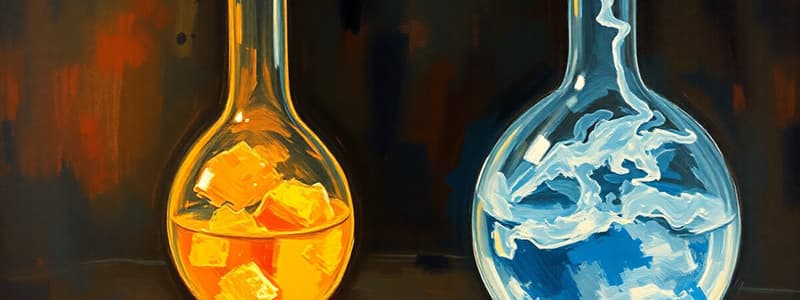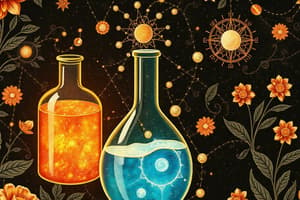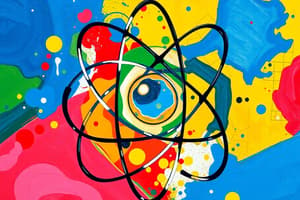Podcast
Questions and Answers
A ______ is anything that has mass and occupies space.
A ______ is anything that has mass and occupies space.
matter
In the periodic table, elements are arranged in vertical columns called ______.
In the periodic table, elements are arranged in vertical columns called ______.
groups
The type of bond formed when two atoms share electrons is called a ______ bond.
The type of bond formed when two atoms share electrons is called a ______ bond.
covalent
Distinguished by their properties, metals, nonmetals, and ______ are categories of elements.
Distinguished by their properties, metals, nonmetals, and ______ are categories of elements.
In a chemical reaction, the substances that undergo a change are known as ______.
In a chemical reaction, the substances that undergo a change are known as ______.
Flashcards are hidden until you start studying
Study Notes
Basic Concepts of Chemistry
- Matter: Anything that has mass and occupies space.
- Elements: Pure substances that cannot be broken down. Examples include hydrogen, oxygen, and gold.
- Compounds: Substances formed from two or more elements chemically bonded. Example: Water (H₂O).
States of Matter
- Solid: Definite shape and volume; particles are closely packed.
- Liquid: Definite volume but takes the shape of its container; particles are close but can move past each other.
- Gas: No definite shape or volume; particles are far apart and move freely.
Atomic Structure
- Atoms: Basic units of matter composed of:
- Protons: Positively charged particles in the nucleus.
- Neutrons: Neutral particles in the nucleus.
- Electrons: Negatively charged particles orbiting the nucleus.
Chemical Bonds
- Ionic Bonds: Formed through the transfer of electrons from one atom to another.
- Covalent Bonds: Formed when two atoms share electrons.
- Metallic Bonds: Involves pooling of electrons between many atoms.
Chemical Reactions
- Reactants: Substances that undergo a change.
- Products: New substances formed as a result of the reaction.
- Types of Reactions:
- Synthesis: Two or more substances combine to form a new compound.
- Decomposition: A compound breaks down into simpler substances.
- Single Replacement: An element replaces another in a compound.
- Double Replacement: Components of two compounds exchange places.
The Periodic Table
- Groups: Vertical columns; elements share similar properties.
- Periods: Horizontal rows; properties change progressively.
- Metals, Nonmetals, and Metalloids: Distinct categories based on properties.
Acids and Bases
- Acids: Substances that produce hydrogen ions (H⁺) in solution. Example: Hydrochloric acid (HCl).
- Bases: Substances that produce hydroxide ions (OH⁻) in solution. Example: Sodium hydroxide (NaOH).
- pH Scale: Measures how acidic or basic a solution is (0-14 scale).
Stoichiometry
- Mole Concept: A mole represents 6.022 x 10²³ particles (Avogadro's number).
- Balancing Equations: Ensures the number of atoms for each element is equal on both sides of the equation.
Thermochemistry
- Endothermic Reactions: Absorb energy (heat) from surroundings.
- Exothermic Reactions: Release energy (heat) to surroundings.
- Enthalpy (ΔH): Heat content of a system at constant pressure.
Organic Chemistry
- Hydrocarbons: Compounds made solely of carbon and hydrogen.
- Functional Groups: Specific groupings of atoms within molecules that dictate their properties (e.g., hydroxyl, carboxyl).
Inorganic Chemistry
- Salts: Formed from the reaction of acids and bases.
- Transition Metals: Elements found in groups 3-12, known for forming various oxidation states.
Biochemistry
- Macromolecules: Includes carbohydrates, proteins, lipids, and nucleic acids.
- Enzymes: Biological catalysts that speed up reactions without being consumed.
Laboratory Techniques
- Titration: Technique to determine concentration of a solution.
- Filtration: Separation technique to remove solids from liquids or gases.
- Chromatography: Method for separating mixtures based on differential affinities.
Basic Concepts of Chemistry
- Matter encompasses anything with mass and volume.
- Elements are the simplest forms of matter, such as hydrogen, oxygen, and gold, and cannot be chemically broken down.
- Compounds are combinations of two or more elements bonded chemically, exemplified by water (H₂O).
States of Matter
- Solids maintain a fixed shape and volume due to tightly packed particles.
- Liquids have a fixed volume but adapt to the shape of their container, allowing particles to slide past one another.
- Gases lack a defined shape and volume, with particles dispersed and moving freely.
Atomic Structure
- Atoms are the fundamental units of matter, consisting of three primary particles:
- Protons are positively charged and reside in the nucleus.
- Neutrons are neutral particles, also located in the nucleus.
- Electrons are negatively charged and orbit around the nucleus.
Chemical Bonds
- Ionic bonds result from the transfer of electrons from one atom to another, creating charged ions.
- Covalent bonds occur when two atoms share electrons to achieve stability.
- Metallic bonds involve a shared pool of electrons among a lattice of metal atoms.
Chemical Reactions
- Reactants are the starting substances in a chemical reaction, which transform into products, the new substances formed.
- Types of chemical reactions include:
- Synthesis: Formation of a compound from simpler substances.
- Decomposition: Breakdown of a compound into simpler components.
- Single Replacement: An element substitutes another in a compound.
- Double Replacement: Exchange of components between two compounds.
The Periodic Table
- Groups are vertical columns where elements exhibit similar chemical properties.
- Periods are horizontal rows where element properties vary progressively across the row.
- Elements are classified as metals, nonmetals, and metalloids, reflecting their distinct characteristics.
Acids and Bases
- Acids generate hydrogen ions (H⁺) when dissolved in water, such as hydrochloric acid (HCl).
- Bases produce hydroxide ions (OH⁻), with sodium hydroxide (NaOH) being a common example.
- The pH scale ranges from 0 to 14, quantifying the acidity or basicity of a solution.
Stoichiometry
- The mole represents a quantity of 6.022 x 10²³ particles, known as Avogadro's number.
- Balancing chemical equations ensures a conservation of mass, with equal numbers of each type of atom on both sides of the equation.
Thermochemistry
- Endothermic reactions absorb heat from their surroundings, resulting in a temperature drop.
- Exothermic reactions release heat, often making the surrounding environment warmer.
- Enthalpy (ΔH) refers to the total heat content of a system under constant pressure.
Organic Chemistry
- Hydrocarbons consist solely of carbon and hydrogen atoms, forming the basis of many organic compounds.
- Functional groups are specific atom arrangements that define the chemical behavior of organic molecules, such as hydroxyl (-OH) and carboxyl (-COOH) groups.
Inorganic Chemistry
- Salts are formed through acid-base neutralization reactions.
- Transition metals, located in groups 3-12, are characterized by their ability to form multiple oxidation states and complex ions.
Biochemistry
- Macromolecules encompass large biological molecules, including carbohydrates, proteins, lipids, and nucleic acids.
- Enzymes are biocatalysts that accelerate chemical reactions without undergoing permanent changes themselves.
Laboratory Techniques
- Titration is a quantitative analytical method used to determine the concentration of a solute in a solution.
- Filtration separates solids from liquids or gases, effectively purifying mixtures.
- Chromatography is employed for separating and analyzing components of mixtures based on varying affinities for a stationary phase.
Studying That Suits You
Use AI to generate personalized quizzes and flashcards to suit your learning preferences.




